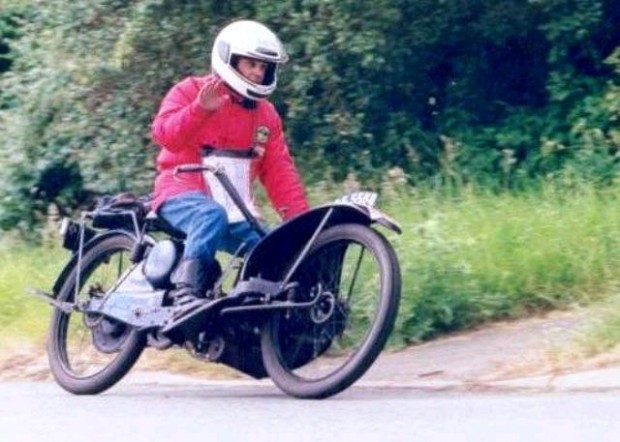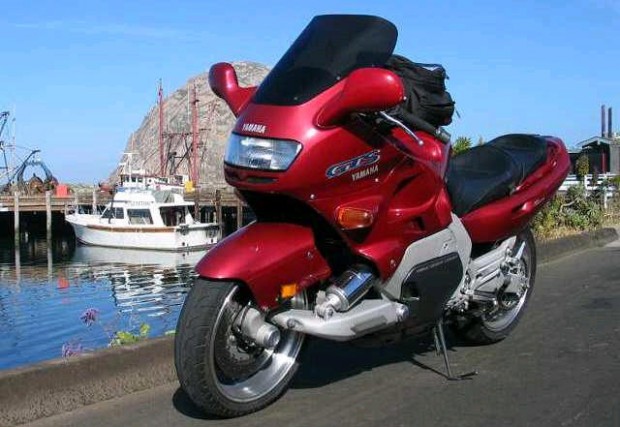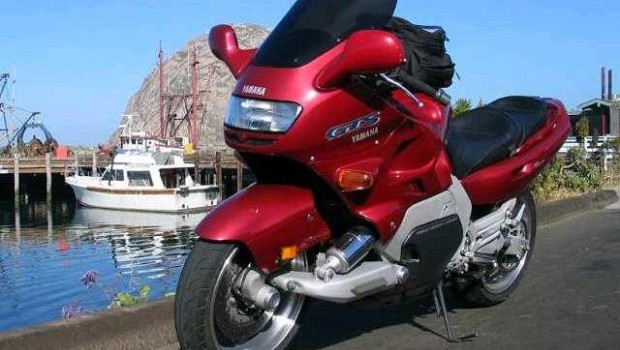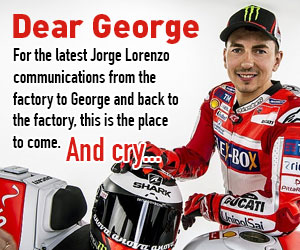HISTORY OF THE FRONT END – PART II
HUB CENTRE STEERING
In 1918, Carl Neracher designed a revolutionary motorcycle.
He called it the Ner-a-Car. Get it? Ha. It had a 221cc two stroke engine. It had an infinitely variable friction drive transmission. It had a monocoque chassis. And it had hub-centre steering.
Between 1921 and 1927, he sold about ten thousand of them in the USA and six and a half thousand of them in England.

The 1921 Ner-a-Car. Revolutionary
It was renowned for its stability. The little two-stroke engine sat low, with the cylinder head popping up between the rider’s feet. The fuel tank was under the seat. All the weight in the chassis was low. There was no rear suspension until the 1925 model, but a sprung swinging arm supported the front wheel, and the steering mechanism was inside the front hub, operated by a linkage connected to the handlebars. There are still fifty or so in existence, and five of them are in Australia.

Ner-a-Car showing under-seat fuel tank and low motor placement
Carl Neracher was probably the first man to think outside the square and get away from the traditional fork. The swinging arm had plenty of attractions as a front suspension though. Its movement was easy to control, the weight was kept low, the suspension force was not transferred to the frame via a small steering head, there was no static friction interfering with the suspension action, and if the swinging arm was angled down slightly, there was a natural anti-dive built into the geometry. (This was probably not real relevant on the Ner-a-Car, which had no front brake, but a two-part rear brake: one half controlled by a handle bar lever and the other half controlled by a foot pedal.)

Inside a diFazio hub-centre front end
This separation of the braking, steering and suspension functions led others to build hub-centre steering suspensions, but not for some years.
In the late 1960s a British engineer called Jack diFazio started experimenting with hub-centre designs. His creations tended to have a large diameter hub which didn’t spin but did steer, and which was connected to the axle via a kingpin. A larger hub was mounted to the outside of this steering hub and spun on ball or roller bearings, and the wheel was laced to this larger hub.
The inner hub is steered via an A-frame on each side of the wheel which is connected at the top of the wheel and to which the steering linkages mount. The brake calipers are attached to this A-frame. The axle is held by a forward facing swingarm and the suspension is attached to this swingarm, separating suspension from steering.

A Suzuki GT550 with a diFazio front end
diFazio’s custom front ends became very popular in Britain and Europe. They weren’t pretty, but they were clever and they worked. The main disadvantages were a reduced steering lock and occasional failures of the heavily loaded kingpin, but many customers thought the advantages in roadholding and stability outweighed these. And while it didn’t look pretty, it looked trick.
Race developers were noting the advantages of the separation of braking, steering and suspension as well. In the eighties Elf created a succession of Honda-engined GP bikes with centre-hub steering and Mead and Tomkinson used a very diFazio-like front end on their endurance racer Nessie. The Elf machine started competing in 1985, and in 1987 Ron Haslam rode it to 4th place in the World Championship.

The 1988 Elf Honda 500 GP racer
The first manufacturer to decide to incorporate hub-centre steering into a production motorcycle after the Ner-a-Car was Bimota. In 1991 they released the Tesi 1D, a hub-centre steered machine with a Ducat 851 motor. It never became popular because it’s a Bimota, and they’re too expensive to become popular.
Then, in 1993, Yamaha released the GTS-1000.
It was, for the time, a technological tour de force. It had electronic fuel injection, ABS brakes front and rear, a three-way catalytic converter and a de-tuned version of the FZR sportster’s 1002cc 5-valve watercooled engine. And it had what Yamaha called RADD front suspension. RADD stood for Rationally ADvanced Design.

The Bimota Tesi 1D: first production hub-centre steerer since the Ner-a-Car
An upright beam was mounted to a single sided swingarm at the bottom and a wishbone at the top. The bike was steered by rotating the beam with a telescopic steering linkage connected to the handlebars. The front wheel hub was offset, and there was a single large inboard brake disk with a six-piston caliper.
Buyers stayed away in droves, and Yamaha stopped making them in 1996.
By all accounts the GTS-1000 handled a treat and went like stink, but the trick technology translated into a price tag that not many wanted to pay. Kawasaki’s ZX-11 was $3,000 cheaper.
Personally, I’ve always thought the GTS1000 was sex on a stick. I’m not alone. Last year, Bike magazine called the 1994 Yamaha GTS1000 the coolest of rare motorcycles. “Scarce, stylish, yet capable and completely usable: that’s cool in our book.”

The 1993 Yamaha GTS1000: “Scarce, stylish, yet capable and completely usable: that’s cool in our book.”
As at the time of writing, there are only three hub-centre steerers on the market. And they’re all Italian.
Bimota still make one – the Tesi 3D. The other two are the Vyrus 2D and 4D.
We’ve looked at girder forks in part I of this series. We’re going to look at other types of front suspension in future articles. The interesting thing about hub-centre steering is that every motorcycle we researched in writing this article had a reputation for being a sweet handler.

The Vyrus 2D. Don’t ask. You can’t afford it
There were plenty of girder-forked bikes that had a reputation for handling like pigs over the years. And we can all name a dozen telescopic-forked bikes that handled like pigs.
But every hub-centre steerer from the Ner-a-Car forward had a reputation for steering nicely.
Interesting, huh?









